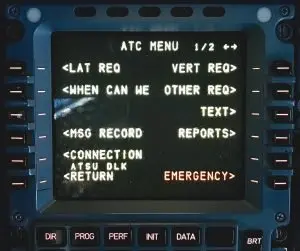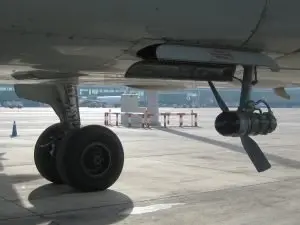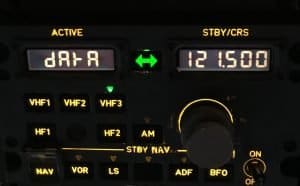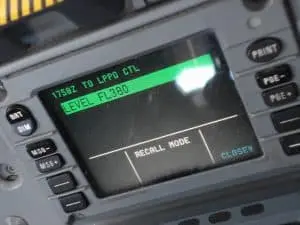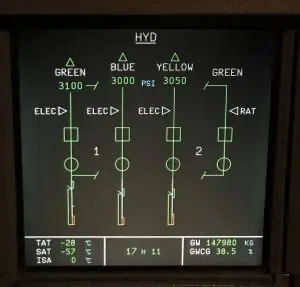I may earn a small commission from links on this page, but I only recommend quality products I trust.

Pete has been flying aircraft for the last 20 years. He has flown everything from light piston aircraft up to heavy jets as both First Officer and Captain. He’s currently enjoying life flying the Airbus A330 for a major international airline.
ADS-B and ADS-C are Air Traffic Control surveillance technologies used on modern aircraft that transmit highly accurate position reports (along with other information) from the aircraft.
Although very similar in operation there some key differences between these two technologies.
Let’s take a look.
Table of Contents
What is ADS-B?
ADS-B (Automatic Dependent Surveillance – Broadcast) automatically and continually broadcasts surveillance data to any station capable of receiving them (e.g. ATC ground stations and also other aircraft).
These transmissions are done through the Mode S transponder and include highly accurate position reports using GPS.
This highly accurate position reporting (more accurate than from ATC radars) gives ATC the advantage of being able to reduce the required separation and make better use of the airspace.
Additionally, it increases safety and reduces risk in non-radar areas such as in the North Atlantic (NAT) region.
An interesting point about ADS-B is that as the reports are transmitted in plain text you can actually receive them on a home PC and even share them automatically to popular flight tracking apps such as Flight Aware, Flight Radar 24, Plane Finder or ADSBExchange.
Clever tinkers have worked out that with a cheap PC Dongle (check price on Amazon) you can turn your computer into a flight tracking machine!
If you’d like to feed into these networks 24/7 then you can plug the dongle into a cheap Raspberry Pi (check price on Amazon) and feed all day long.

The 5 Best Aviation Audiobooks (Chosen by a Pilot) A list of the best aviation audiobooks chosen by a current airline pilot. From fascinating stories at the dawn of aviation to modern day aircraft accidents.
What is ADS-C?
In a similiar way to ADS-B, ADS-C (Automatic Dependent Surveillance – Contract) transmits regular and highly accurate position reports to Air Traffic Control.
More about ADS-C here – Inmarsat.
However, the “Contract” element of ADS-C refers to a contract, established by the ground station, between the aircraft and that ground station. This contract is established and controlled by the ground station.

What Are The Main Differences Between ADS-B and ADS-C?
The main differences between ADS-B versus ADS-C revolve around the types of connections, how the systems are used and the ways in which they communicate.
- Broadcast versus Contract
ADS-B “broadcasts” reports to any station capable of receiving them. These broadcasts are automatic and continuous and are not in response to requests from ground stations (as opposed to ADS-C).
ADS-C is a “contract” between the aircraft and a specific ground station. The contract is established and controlled by the ground station and this contract determines what information is to be sent and when it will be transmitted – the information is not broadcast to all stations as with ADS-B. - Use Case: ADS-B vs ADS-C
ADS-B aircraft positions are updated much more often than those operating ADS-C. As such, ADS-B provides a much more accurate picture to Air Traffic Control. The accuracy of the position reporting allows ADS-B position plots to be considered surveillance control.
ADS-C how is updated over longer periods (approx. 10-minute intervals) and such is typically used over remote and oceanic areas. - Transmission Method
ADS-B is transmitted by the aircraft’s Mode S Transponder and therefore has a more limited range.
Related: ACARS Use Explained
ADS-C is transmitted over the ACARS network via SATCOM (Satellite Communications) and therefore is not limited in range as for ADS-B. ADS-C can operate either with CPDLC (Controller Pilot Data Link Communications) or independently on its own.
Related: CPDLC (Controller Pilot Data Link Communications) – A Pilot’s Guide

The 5 Best Aviation Audiobooks (Chosen by a Pilot) A list of the best aviation audiobooks chosen by a current airline pilot. From fascinating stories at the dawn of aviation to modern day aircraft accidents.
Video Examples of ADS-B and ADS-C
Related: A Guide to Aircraft Transponders
Further Reading on ADS-B and ADS-C
FAA Next Gen Programs: ADS-B
Wikipedia: ADS-B
INMARSAT Blog: ADS-C
ICAO Global Operation Data Link Document (GOLD) is a great resource for more info on both ADS-B and ADS-C.
If you found this article interesting please take 5 seconds to share this on your favorite social media. Thanks so much, I really appreciate it! [email protected]

Pete has been flying aircraft for the last 20 years. He has flown everything from light piston aircraft up to heavy jets as both First Officer and Captain. He’s currently enjoying life flying the Airbus A330 for a major international airline.

